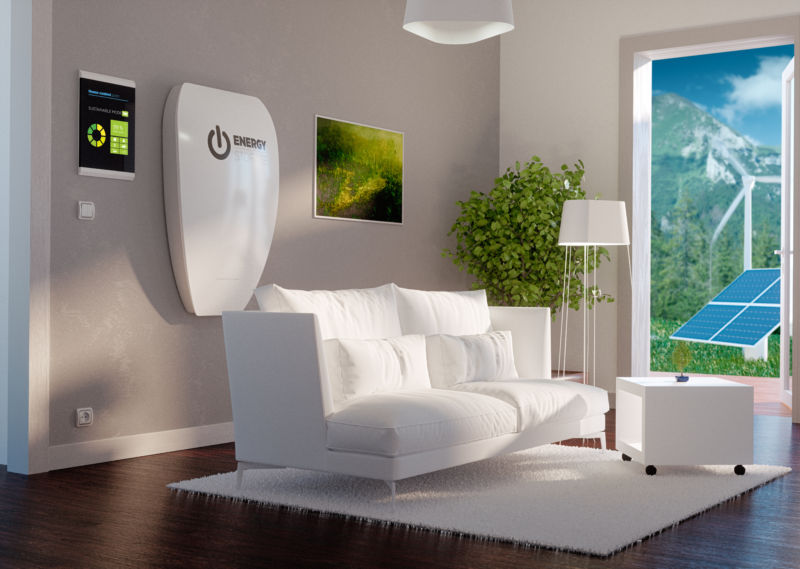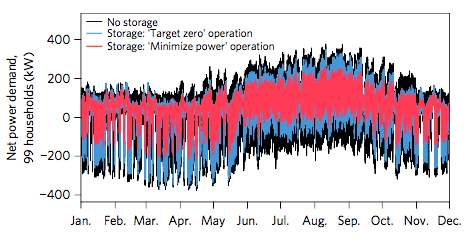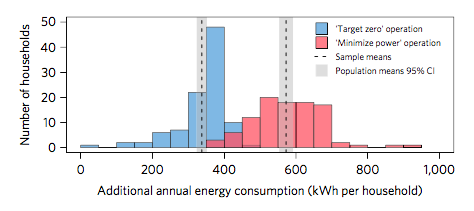
Batteries are a big deal these days in renewable energy—utilities are investing in grid-scale lithium-ion battery installations to help smooth out the intermittency of renewables. But smaller, residential battery installations have also been on the rise thanks in part to Tesla’s new Powerwall 2 and Sonnen’s recent entry into the US market.
But a new study published in Nature Energy from University of Texas researchers Robert L. Fares and Michael E. Webber suggest that people who buy home batteries should carefully consider their motivations for the purchase. For homes that remain grid-tied, batteries may actually increase annual energy consumption for a household by 324–591 kWh. Depending on the region a house is in, using more power could lead to increased carbon emissions.Instead, the researchers concluded, homeowners that want to help reduce emissions as much as possible are better off getting solar panels and selling that power back to the grid—at least in most markets.
Of course, some people want batteries for reasons other than reducing emissions—like preparing for grid outages or going completely off-grid with solar panels and multiple batteries, for example. Fares and Webber didn’t look at those use cases, but they focused on the primary value proposition for customers that are already grid-tied—that is, reducing but not severing connection with the grid on a daily basis.
The researchers accounted for two different styles of battery operation in their research: a “target zero” battery whose software doesn’t have predictive capabilities and simply tries to reduce a home’s interaction with the grid at all times, as well as a “minimize power” battery that can predict future levels of electricity demand and solar generation and plans its operation to minimize net power demand over the course of the day. A “target zero” battery only charges on solar energy, while a “minimize power” battery will charge from the solar panels or from the grid. In other words, “‘target zero’ prioritizes being as independent as possible during the current minute, while ‘minimize power’ prioritizes being as independent as possible over the entire day,” the paper explains.
The study found that with a “target zero” battery, peak demand for electricity decreased by eight percent, but mean annual energy use increased by eight percent. With a “minimize power” battery, peak demand decreased by 32 percent, but annual energy use increased by 14 percent. The increases in energy use come from batteries drawing on power while they charge and discharge, as well as losses introduced by inverters and thermal control systems used in the battery. In a blog post on Scientific American, Fares writes that "about 15 percent of the energy that goes into a state-of-the-art battery system is lost to inefficiencies."
The researchers specifically looked at the energy consumption of 99 homes in Texas and concluded that adding a 3.3 kW, 7 kWh, daily-cycling battery would indirectly increase emissions by 153–303kg of carbon dioxide (CO2), 0.03–0.20kg of sulfur dioxide (SO2), and 0.04–0.26kg of nitrogen oxide (NOX) annually. For context, the average family of four in Austin, Texas, is indirectly responsible for about 1,000kg of CO2 emissions annually, according to the EPA’s Carbon Footprint Calculator.


That increased energy consumption from batteries translates to increased emissions from utilities, in part due to the fact that the batteries time-shift demand for energy. “The change in grid emissions from the addition of home battery energy storage is caused by two separate factors: the additional energy consumption required to cover storage inefficiencies, and the fact that storage shifts electricity demand in time, and alters which generators are used to provide energy not produced from rooftop solar panels.” Fares and Webber looked at marginal emissions factors from the Texas electricity system, which relies primarily on fossil fuels, to estimate additional emissions caused by home batteries. One could assume on a grid with less greenhouse gas emissions that these numbers would be smaller.
Still, there’s nuance to the story. The researchers admit that on average, increases in energy consumption from a battery are small compared to decreases in energy consumption from adding new solar panels. So if your choice is to add solar panels and a battery, you’ll see a net decrease in energy consumption and emissions. But you won’t see as big of a decrease in energy consumption and emissions as you would if you simply added solar panels. And, if you’re adding a battery to existing solar panels, expect energy consumption to increase.
One interesting thing the researchers noted was that their models—specifically for the “minimize power” batteries—reduced the magnitude of power flows from rooftop solar into the grid and reduced the need for new generation capacity to meet peak demand. So while overall demand for electricity might be higher, utilities might see less strain on the grid. That suggests that utilities might see reason to encourage home energy storage.
Nature Energy, 2017. DOI: 10.1038/nenergy.2017.1 (About DOIs).
reader comments
144